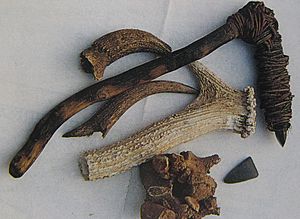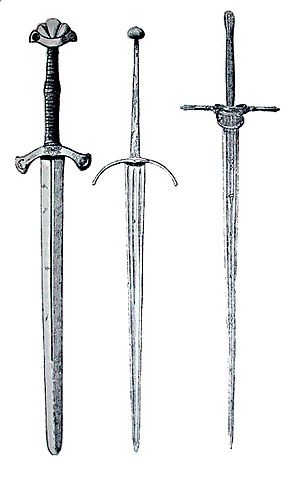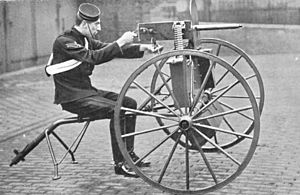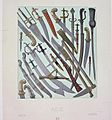Weapon facts for kids
A weapon is an object used to attack or hurt a person or animal. People have used weapons for a very long time. While some animals use parts of their bodies as weapons, like teeth or claws, humans use tools that are separate from their bodies. Humans have always been inventing newer and better weapons. This started when they first picked up a rock to use.
Contents
History of Weapons
Some of the oldest things we have from ancient people are stone weapons. Early humans also used spears. Bows and arrows were used as far back as 20,000 BC.
During the Bronze Age, people learned to make things from metal. Many people started using swords. People also built huge machines to throw rocks. These machines could destroy the walls of enemy cities. Some were called catapults or siege engines.
Later, gunpowder was invented in China. Europeans then began using gunpowder to make guns and cannons. These new weapons were much more powerful than older ones. They helped Europeans explore and settle in many parts of the world. People used guns like rifles and shotguns for hunting. They used handguns for fighting other people.
Modern Weapons
People kept inventing new weapons. In 1884, the machine gun was invented. It could shoot many bullets very fast. Soldiers also started using land mines. A land mine is a bomb hidden in the ground. It explodes when someone walks on it.
Small submarines began using torpedoes to attack bigger ships. They could hide under the ocean. When airplanes were invented, people used them to shoot enemies. They also dropped bombs from planes. Tanks were built with big guns and strong armor. Poison gas was used in World War I. However, it was later outlawed and rarely used again.
In World War II, cities were heavily bombed from the air. Nazi Germany used V-2 missiles to carry bombs to England. Both sides used many firebombs. At the end of World War II, the United States used atomic bombs. These powerful nuclear bombs destroyed the Japanese cities of Hiroshima and Nagasaki.
After World War II, new weapons continued to be developed. These included intercontinental ballistic missiles. People became worried about "weapons of mass destruction." These are weapons that can kill many people very quickly. They are often cheap and easy to make and use. Poison gas is one type of weapon of mass destruction. New kinds of poison gas, like nerve gas, are much stronger than old ones. Another type is disease germs. These could be used to make many people sick or even kill them.
Laws About Weapons
Old-fashioned weapons still cause many deaths in wars and fights. For example, in wars in Africa in the 1990s, many people were killed with large knives called machetes.
People sometimes try to make laws and agreements to control weapons. This is because they are concerned about all the killing that happens. Laws about weapons are different in each country. For example, in the United States, citizens have the right to own and carry weapons. This right is part of their Constitution.
Some countries may say that people cannot own or use guns. Or they may only allow it if the government gives permission. There are also "laws of war" that forbid certain weapons. Countries might agree not to use certain weapons against each other. They might also agree to only have a certain number of particular weapons.
Types of Weapons
Here are some types of weapons:
Weapons Ordinary People Can Carry
These are things specifically made as weapons. They include non-lethal items like:
- Pepper spray or tear gas
- Electric shocking devices
Weapons for Soldiers and Police
These are weapons carried by soldiers or police officers:
- Portable firearms like pistols, rifles, and shotguns
- Portable firearms are also used for hunting and target practice.
- Some types of sticks
- Swords and most types of knives
Weapons for National Defense
These are weapons used by a country's government for defense:
- Explosive bombs of any type, and hand grenades
- Rockets for carrying bombs
- Boats, vehicles, and aircraft with attached firearms. Examples include warships, tanks, and fighter or bomber aircraft.
Other Types of Weapons
- Sling
- Slingshot
- Spear
- Bow and arrow
- Flamethrower
- Biological weapon
Related pages
Images for kids
See also
 In Spanish: Arma para niños
In Spanish: Arma para niños








